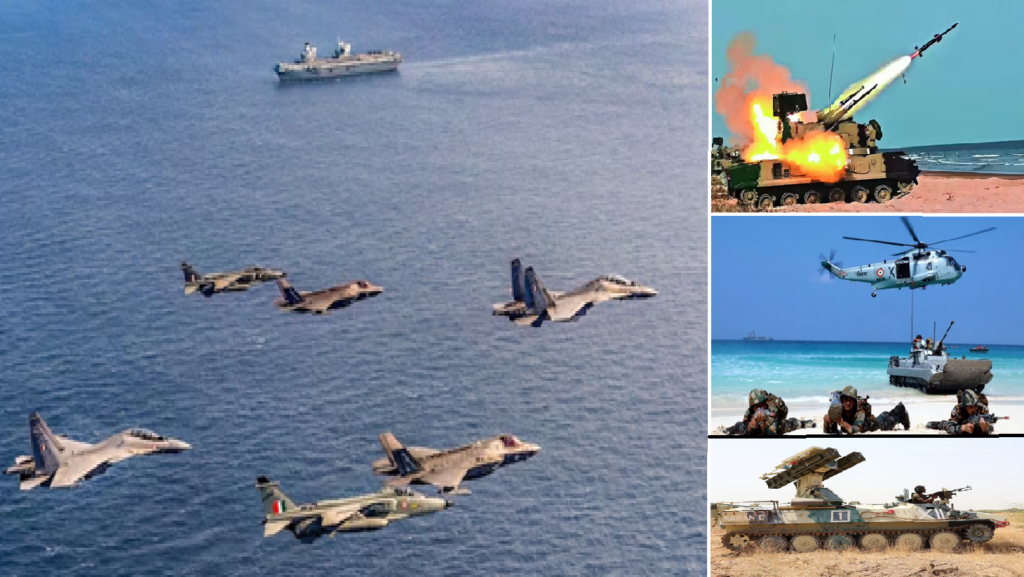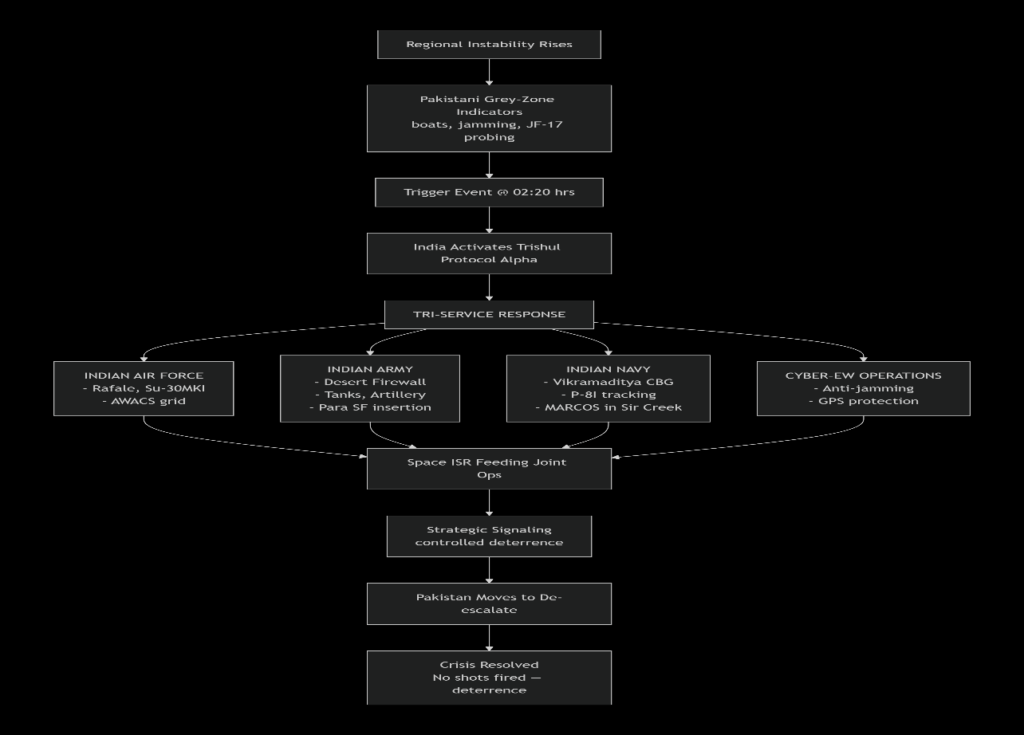
- Exercise Trishul 2025 underscored India’s expanding multi-domain warfighting capacity, vital for a developing three-front threat across the maritime, northern, and western axes.
- Senior commanders noted that the system aimed to validate—rather than merely display—India’s joint warfare doctrine built on real-time interoperability across air, land, sea, cyber, and electronic domains.
- Exercise Trishul 2025 showed India’s ability to execute fast, coordinated operations in a potential three-front conflict spanning the western, northern, and maritime theatres.
- Trishul 2025 demonstrated that India is now a fully integrated, multi-domain force capable of quick, precise, and escalation-controlled operations across land, air, sea, cyber, and space.
Exercise Trishul 2025 served as a potent symbol of India’s growing capacity for multi-domain warfighting, which is essential in the developing three-front conflict environment where attacks are anticipated to come from the maritime, northern, and western domains at the same time. The simulation showed how all elements of electronic, cyber, air, sea, and land combat were fully integrated throughout the Western theatre. With over 20,000 soldiers, including mechanised infantry, artillery brigades, missile units, air-defence detachments, attack helicopters, and armoured regiments with T-90S Bhishma and Arjun Mk-I tanks, the Southern Command was the main formation of the Indian Army that led its land operations. Their actions were in line with the Chanakyan notion that true strategy is based on competence.
Large-scale drills throughout the Thar Desert, such as those at Maru Jwala and Akhand Prahaar, kept soldiers proficient on long-range weapons, deep-strike tactics, and mechanised offensives. These tactics echoed the Mahabharata’s assertion that the greatest assets and psychological foundation of warfighting are a strong will to fight and enthusiasm.
In the Kutch and Sir Creek sectors, integrated multi-domain drills were carried out by the Army, Navy, Air Force, Coast Guard, and BSF. This is crucial in a three-front conflict. The Arthashastra’s advice to “protect your vital resources during crisis” was reflected in the operations, which were vigilant on India’s precarious western flank. Fully integrated land-sea-air combat capacity was demonstrated with amphibious landings and beach assaults along the Saurashtra coastline, in keeping with Sun Tzu’s strategic axiom, “Where there is chaos, there is opportunity.”
Trishul has expanded from a relatively straightforward naval exercise in the early 2000s to a large tri-service, multi-domain exercise under the auspices of the Western Naval Command. The Arabian Sea theatre was dominated by carrier battle group operations, air defence missions, and anti-submarine warfare, all of which reinforced the strategic reality that practice makes perfect.
Innovation, teamwork, and Aatmanirbhar Bharat are the hallmarks of Lt General Dhiraj Seth’s leadership. India has greater technological autonomy thanks to its own drones, EW systems, communication networks, counter-drone suites, and loitering bombs. This exemplifies the military adage that experts concentrate on logistics rather than just strategy. Exercise Trishul 2025 is essentially a strong deterrent message. It has been demonstrated that India’s armed forces are prepared for cooperative and decisive operations in a challenging three-front scenario. To reiterate what the Gita said, “Duty lies in action, not in reward.” Trishul is a living example of self-control, solidarity, and preparedness.
Tri-Service Integration and Force Deployment
One of its main characteristics was its capacity to synchronise and scale tri-service deployment. Twenty to twenty-five front-line vessels, including destroyers, frigates, submarines, and amphibious ships, were deployed by the Indian Navy, which dominated the military. Nearly forty aircraft, including Rafales, Sukhoi-30 MKIs, Jaguars, AWACS, and mid-air refuelers with deep-strike capability, air dominance, and electronic warfare responsibilities, were delivered by the Indian Air Force. The Indian Army organised large formations of air defence troops, long-range rocket artillery, infantry combat vehicles, and T-90 and Arjun tanks. The purpose of this system, according to senior commanders, was to validate—that is, not merely demonstrate—India’s joint warfare doctrine, which calls for real-time interoperability across the air, land, sea, cyber, and electronic domains.
Weapons Used in Tri-Service Exercise Trishul 2025
| Service | Weapons / Platforms |
| Indian Army | T-90 Bhishma Tanks Arjun MBT BMP-2 Infantry Combat Vehicles Pinaka Multi-Barrel Rocket System Bofors FH-77B Howitzers Dhanush Artillery Guns Akash Air Defence Missile System Anti-Tank Guided Missiles (ATGMs) |
| Indian Air Force | Rafale Fighter Jets Su-30MKI Tejas LCA Mirage-2000 Jaguar Strike Aircraft Netra / AWACS Surveillance Aircraft C-130J / C-17 Transport Aircraft Attack Helicopters (Rudra, ALH) Heron / RPAS Drones |
| Indian Navy | Kolkata-class & Delhi-class Destroyers Shivalik-class & Talwar-class Frigates Scorpene-class & Kilo-class Submarines INS Jalashwa (Amphibious Ship) Landing Craft Utility (LCU) P-8I Maritime Patrol Aircraft MH-60R Naval Helicopters BrahMos & Barak-8 Ship-Launched Missile |
Network-Centric and Multi-Domain Operations
Testing India’s network-centric combat architecture was one of Trishul’s main goals. The Agni Drishti sensor-to-shooter network, which links satellites, drones, marine patrol planes, and ground radars with strike platforms into a single information and targeting system, was validated during the exercise. By giving commanders access to real-time combat information, this network allowed them to make decisions more quickly and accurately. In order to interfere with communications and electronic signatures, the Trinetra project used cyber operations, GPS-denial exercises, and electronic warfare against fictitious enemy networks. These are a reflection of India’s gradually rising realisation that contemporary warfare depends more and more on the smooth transfer of information throughout the battlefield and transcends physical platforms. The exercise laid great emphasis on indigenous systems, reinforcing India’s commitment to Aatmanirbhar Bharat. Indigenously developed drones, electronic-warfare suites, counter-drone systems, naval combat-management software, secure communication networks, and loitering munitions were extensively integrated into the operations. The confidence with which the services fielded these systems signals a maturing domestic defence ecosystem that is slowly reducing reliance on foreign suppliers. Trishul, therefore, served as both a battlefield validation of indigenous platforms and a stress test to identify areas requiring further technological improvement.
Indigenous Systems Used in Trishul 2025
| Category | Indigenous Weapons / Systems |
| Drones & UAVs | Rustom-II / TAPAS-BH UAV SWARM Drones (ALFA-S, Nagastra-1) Switch UAV |
| Loitering Munitions | ALS-50 Loitering Munition Nagastra-1 Loitering Munition |
| Electronic Warfare & Communication | Samyukta EW System Divya Drishti EW Suite Secure Data Link–II (Navy) Uttam AESA Radar |
| Artillery & Missile Systems | Akash Surface-to-Air Missile Pinaka MBRL Dhanush Artillery Gun ATAGS (Advanced Towed Artillery Gun System) |
| Naval Indigenous Systems | Combat Management System (CMS-17) Shakti Naval EW Suite BrahMos (Indo-Russian, Indian production majority) Indigenous Sensors on Shivalik-class |
| Aircraft & Helicopters | Tejas LCA ALH Dhruv Rudra Attack Helicopter |
| Counter-Drone Systems | DRDO Anti-Drone System Zen Anti-Drone Shield |
India Tests Rapid Tri-Service Response in a Three-Front War Scenario
Exercise Trishul 2025 demonstrated India’s capability for fast and coordinated operations in a potential three-front conflict at the western, northern, and maritime theatres of operation with simultaneous threats. The exercise simulated a sudden escalation where hostile forces launched hybrid attacks, attempted airspace violations, and triggered cyber disruptions.
Early-warning assets, fighter scrambles, and air dominance were all brought into effect to provide the initial response by the Indian Air Force. Next came a mix of Integrated Battle Groups mobilisation, reinforcement of high-altitude positions and long-range artillery, and air defence systems deployment by the Indian Army. The Navy completed the third phase with rapid carrier-group deployment, submarine tracking, and coastal security operations across the Arabian Sea and Bay of Bengal. A unified command structure oversaw real-time intelligence fusion, multi-domain logistics, and precision mission planning. Special Forces and space-based ISR added a deeper operational reach. The exercise showcased India’s better preparedness, shorter reaction timelines, and enhanced joint operations doctrine. According to officials, Trishul 2025 reflects India’s alignment toward faster, smarter, and network-centric warfare, building deterrence in an increasingly contested strategic environment.

Signalling and Reactions from Pakistan
Pakistan reacted by escalating its rhetoric while exercising procedural caution. In an indication of increased vigilance, it tightened airspace controls and issued new NOTAMs. Pakistani military officials and state-affiliated media, primarily to reassure domestic audiences, accused India of “false flag” intentions and threatened a harsh response. Increased alertness and minimal troop adjustments were noted along the coastal and frontier sectors, which are typical countermeasures during high-intensity exercises in India. All things considered, Pakistan’s actions demonstrated resolve while cautiously avoiding actions that might directly escalate the situation.
Conclusion
India has emerged as a fully integrated, multi-domain warfighting force that can conduct quick, accurate, and escalation-controlled operations in land, air, sea, cyber, and space, as demonstrated by Exercise Trishul 2025. The war-gaming scenario demonstrates how swift tri-service coordination, smooth intelligence fusion, sensor-to-shooter accuracy, and calibrated action that neutralises threats without causing uncontrollable escalation can be used to counter a hostile provocation. From counter-infiltration in Sir Creek to maritime denial in the Arabian Sea, India’s ability to control the battlefield demonstrates the potency of Trishul’s combined doctrines and homegrown technologies.
The exercise also improves India’s deterrence credibility. With synchronised air superiority, precision fires, amphibious readiness, cyber disruption, and space-enabled surveillance, India established operational overmatch while maintaining political restraint. Pakistan’s defensive and constrained reactions highlight how effective India’s integrated strategy is.
References:
- https://vajiramandravi.com/current-affairs/exercise-trishul/
- https://www.pib.gov.in/PressReleasePage.aspx?PRID=2185528
- https://indianexpress.com/article/cities/pune/western-front-ex-trishul-validates-virtual-physical-land-sea-air-integration-10355774/
- https://www.indiandefensenews.in/2025/11/exercise-trishul-reinforces-tri-service.html
- https://x.com/i/status/1987758307038077310
- https://x.com/i/status/1987510350410117619
- https://x.com/i/status/1987856412173840830
Piyush Anand is a Biotechnology Engineering student at Chandigarh University. His primary interest lies in International Affairs, Defence and Strategy. Views expressed are the author’s own.
